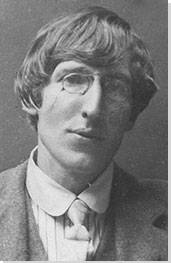Summary of Nikolai Astrup
Frequently referred to as Norway's "other" great Expressionist (next to Edvard Munch, whose work he actually deplored) Nikolai Astrup is best known for his ingenious and unnerving paintings and woodcuts of the western Norwegian landscape and the people who worked it. It is true that Astrup detested color theory and the conventions governing optical perspective, yet his landscapes amounted to much more than a child's-eye reductionism. Rather, his work, which sits between an academic landscape tradition and a form of early-modernist abstraction, is celebrated for its clarity and the intense love and honesty with which he depicted his rural surroundings.
Thematically, his work is engaged with mankind's lifelong relationship with the land and it is steeped in a paganism and ancient folklore that challenged the oppressive Christian community into which he was born, and against which he rebelled. Though the mystical themes in his work sat firmly within a neo-romantic orthodoxy, his art, which remained throughout, quintessentially Norwegian, came to prominence at a time when Norway was promoting a new sense of national pride following its liberation from Swedish rule.
Accomplishments
- Though he was well travelled throughout Europe, Astrup art remained true to his roots and his art was dedicated to the land and pagan customs of Norway (and the Jølster region specifically).
- Astrup imbued his joyous and desolate landscapes with a sense of mysterious spirituality that could evoke emotions ranging through wonder to disquiet (and sometimes all at once). Whereas Expressionists (such as Munch) tended to use art to explore (and expunge) their innermost forebodings and anxieties, Astrup introduced a childlike innocence to his work. This skill lent his intense landscapes a peculiar still and harmony that was unique amongst modern landscapists.
- Astrup (much like Munch) was instrumental in introducing the woodcut technique to Norwegian art. However, Astrup's woodcut reliefs tended to be lighter in color and mood than his compatriot's (who was, incidentally, an early admirer and collector of Astrup's woodcuts).
- Mythical spirits hold a strong place in Norwegian mythology, and a motif in Astrup's work was that of the Troll. The figure of the Troll featured in hand-carved totems in Norwegian gardens and Astrup pruned his own trees, which he subsequently painted, to resemble Trolls.
Important Art by Nikolai Astrup
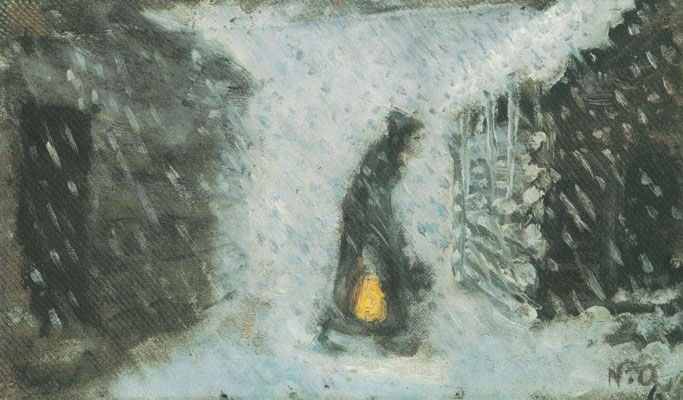
Kjerringa med Lykta (Old Woman with a Lantern)
This is one of three paintings that Astrup created in his youth by painting upon fabric from used trousers, in all likelihood because he was struggling financially and unable to afford canvas (a seam from the trouser leg can be seen at the upper edge of the image).
In the painting, a slightly hunched woman, dressed head-to-toe in black, and carrying a glowing yellow-orange lantern, is seen walking between two dark brown log cabins. The scene is set in winter during heavy snowfall. Long icicles hang from the roof of the right-hand cabin. The space between the two cabins is filled with snow, and large flecks of white snow descends on the cabins and on the woman. Astrup described the painting in his Blandede Motiver ("Mixed Motifs") notebook as follow:
"Early winter morning (fantasy) Snowdrifts. Grey on grey, white and blue, light grey sky with dark grey flakes. The only element not fitting into this grey scheme is a lantern carried by a dark grey figure. The pinkish light cast against the snow fuses with the lantern's form. A vague suggestion of daylight [is] the only [thing] showing itself over the rounded snow shapes on a rooftop [...] The grey probably contains some colors, but these are so subtle, they are not noticed, and nowhere is one stronger than another, to the extent that it sticks out!"
This painting serves as an example of the way that neo-romantic painters used landscape and weather conditions as a way to convey strong memories and emotions as evoked through the forces of nature. In Astrup's early works snow is depicted as a natural adversary to be endured and overcome. In later works, however, snow often appears merely in the background, typically adorning mountaintops. Here it dominates the scene, obliterating the landscape and threatening to envelop the figure driving the picture's narrative. This work also serves as an example of the darker, more ominous quality that characterized much of Astrup's earlier works. It is frequently speculated upon that Astrup's work took on a lighter, more vibrant and joyous, tone following his marriage to Engel in 1907.
Oil on trouser fabric - The Savings Bank Foundation DNB / KODE
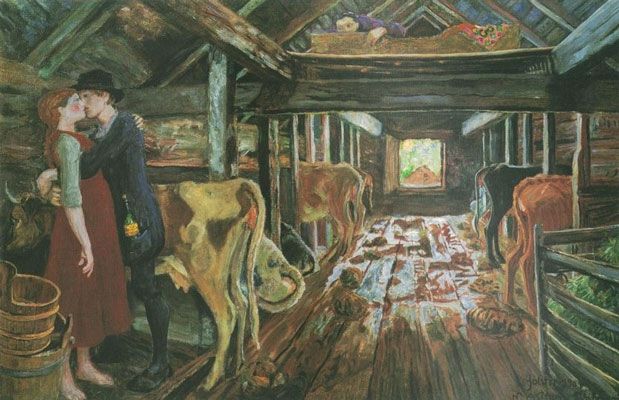
Fjøsfrieri (Cowshed Courting)
In Cowshed Courting, we are given a deep-focus view down the corridor of a wooden barn that houses several cows. Occupying the left of the foreground is a young couple shown in a romantic clinch. The man, dressed in all black - boots, trousers, jacket, and hat, with a bottle of liquor poking out his jacket pocket (maybe it has given him Dutch-courage) - has both his arms wrapped around the girl who is barefoot and wears a green shirt, red dress, and a headscarf. The girl's right arm hang down by her side, but her left arm, draped round her suitor's shoulders, and her deep red blushing cheek, confirm her amorous emotions. At the upper center-right, a male figure laying in the hayloft is seen spying on the kissing couple. Through a window at the back of the barn, a peak can be seen and, beyond that, a glimpse of vibrant green foliage and clear blue skies.
Here then, Astrup combines the theme of romantic love with the formal codes of Romanticism. The passionate romance is obvious to us while the glimpse we are given of the outside world (through the barn window) shows a springtime landscape that belongs to the traditions of Romanticism. These features complement one another and rather foreshadow Astrup's own romantic fate, having fallen in love with a farm girl of his own (Engel) two years later.
Oil on Canvas - The Savings Bank Foundation / KODE
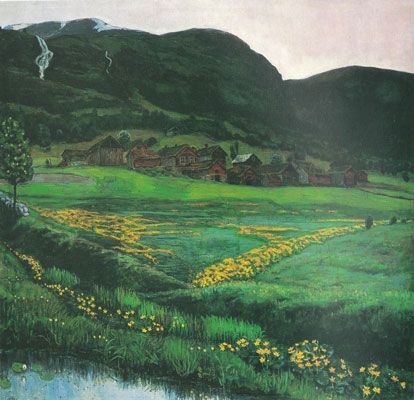
Klar Juninatt (Clear June Night)
This painting depicts a lush green landscape at the foot of a mountain. In the foreground, a small pond is speckled with waterlilies, and surrounded by vibrant green grass. Beyond this we see a field of yellow buttercups. Further back, a small cluster of log buildings indicates the presence of human life within this idyllic setting. In the background, mountains loom over the scene. Streams and waterfalls (Kleberfossen) can be seen on the nearer mountains, while the more distant, taller peaks are capped with snow.
Astrup frequently re-used certain geographic locations as subjects in his works. For instance, this image depicts Ålhustunet in Jølster, and in fact the cluster of buildings (klyngetunet) shown here was perched just above the Ålhus vicarage where Astrup resided for a time. Several of his other works depict the same location. Astrup would modify the landscape by populating it with different figures, and by representing it under the effect of different weather conditions. He once said of a variation on this image "this picture I can almost not remember. One 'goes in circles' when painting so many variations of the same motif, even though one varies it each time and always returns to study nature."
The buttercups in this twilight scene play an important role here since they do not close at sunset. They serve rather as points of light in the shadowy landscape. In fact, Astrup had to travel elsewhere to study buttercups as the marsh at Ålhustunet had been drained some years prior and thus the marsh-loving flowers had long since died out.
The human figures in Astrup's landscape paintings were sometimes positioned in the distance and/or off to the side of the picture plane, as we see here with the two figures to the left of the cluster of buildings in this painting. They do not dominate or detract from the real protagonist of the image, the natural landscape. However, this painting includes a curious feature in the lower left quadrant: what seem to be vague shadows on the landscape reveal themselves to be silhouetted human forms. These forms are generally understood by historians to be a reference to Lørdagsfrieri (Saturday Night Courting) (1893) by Norwegian painter Halfdan Egedius, a painting in which two men walk through a misty field on a summer evening. Egedius and Astrup had both been schooled by Harriet Backer, who's Landskap fra Ulvin (Landscape from Ulvin) (1889), is itself quite similar in form to her pupils' work.
Oil on Canvas - The Savings Bank Foundation DNB / KODE
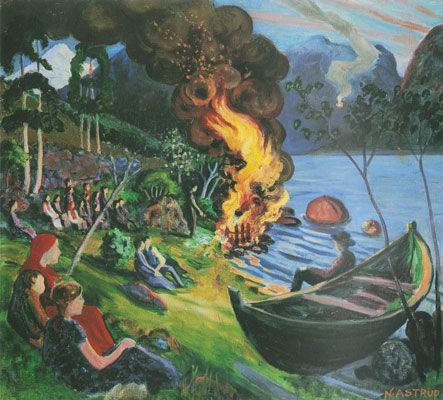
St. Hansbål ved Jølstravatnet (Midsummer Eve Bonfire)
In this vibrantly colored painting, a group of people sit in the grass at the edge of a large lake (known to be in Brenden), surrounding a large yellow-orange bonfire from which orange sparks and black smoke billow upward. Beyond the lake, tall, dark mountains loom in the background. Halfway up one of the mountains, another bonfire can be seen (probably either at Ålhus near Kleberfossen, or at Ålhusdalen), with its grey smoke rising into the sky.
This painting serves as an example of the overall change of tone that can be noted in Astrup's oeuvre following his marriage to Engel. Engel was a significant inspiration and source of positive sentiments for Astrup, who wrote in a letter in 1909, "I cannot afford to lose her, I had almost given up hope in life when I met her, and thanks to her my life-force re-ignited."
The Midsummer Eve bonfires depicted in this painting were part of pagan fertility celebrations and rituals dating back to ancient times. The figure nearest the fire is placing a juniper branch into the fire, which causes the fire to crackle loudly and emit the sparks we see amidst the smoke. Juniper was believed to enhance the protective function of the fire throughout the night, as it was believed that other-worldly beings such as witches were particularly active on Midsummer Eve. Astrup created several versions of the Midsummer Eve scene. Although in this version, the spectators sit and watch quietly, in other versions they participate in lively dancing and music-making (such as fiddle-playing), as music and folk dancing were also important aspects of the Midsummer Eve celebrations.
Astrup created these images from a vivid and troubling childhood memory. He later wrote in an undated letter to Mayor Aslaksen of Arendal in which he recalled "it was sinful for Christians to join the [pagan] celebration. Then [...] I had to stand back behind the fence and look and listen while the others danced around the bonfire and whooped for joy [...] It struck me that the bonfire was something sinful, something bad being practiced in the green dusk - it was pagan. This idea was reinforced by the jealousy festering inside me when the other children could attend, but I had to stand behind the fence." Art critic Claudia Massie noted of this picture, arguably his great masterpiece, that as "a Christian child, Astrup was forbidden to participate in these rituals. Instead, he had to watch, simultaneously seduced and scared by what he saw [...] This conflict is evident in the work. Astrup is an observer, not a participant, and what might in another artist's hands be a glib, gleeful scene becomes something profound and unnerving; the prelapsarian seen through the pastor."
Oil on Canvas
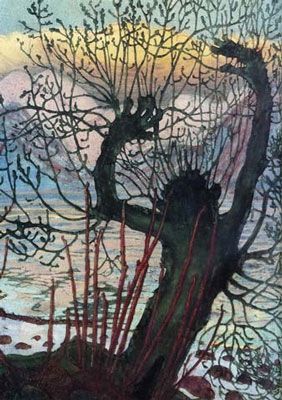
Vårnatt og seljekall (Spring Night and the Call of the Goat Willow)
As far back as 1901, whilst studying in Paris, Astrup had taken an interest in Japanese woodcuttings. But it wasn't until 1914 that he started to focus more seriously on producing his own woodcuts. The title of this work, Seljekall (meaning "the call of the Selje, or goat willow tree"), refers to the whispering sound made by the wind as it blows past the Selje tree. Astrup renders the "calling" tree as a Troll clawing at the sky. At the centre of the tree we see a round head-like shape with protrusions that look like ears, and on either side of this, arm-like branches each with five "fingers" reaching upward. The tree is silhouetted against a natural background (a lake with mountains beyond) rendered with light pastel colors.
As Massie explains, Astrup's notebooks contain "descriptions of funerals, many references to the sickly or 'poisonous' colors he sees in water, marsh or rising from the evil spirit of a herd of swine and, of course, there are musings on trolls. These mythic beings have a mighty hold on the Norwegian psyche [...] Astrup pruned his trees to resemble trolls and made paintings of these tortured creations. It is a curious motif, at once atavistic and twee, the heightened imagination of the child carried into adulthood." With this woodcut Astrup reveals then a somewhat ambivalent relationship with his surroundings: at once calm, serene, dark and menacing.
Hand-colored woodcut
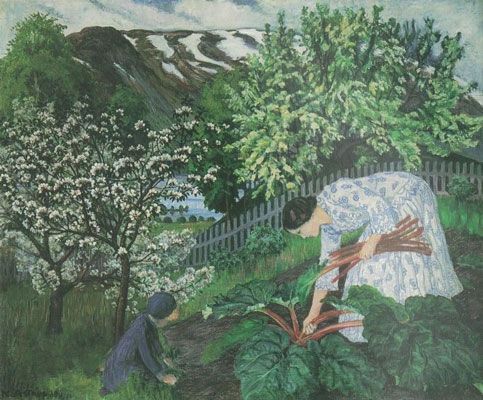
Rabarbra (Rhubarb)
In the foreground of this late career painting, a woman on the right-hand side wearing a blue and white patterned dress, with her dark hair gathered at the nape of her neck, stoops over in a garden gathering stalks of red rhubarb. To our left, a blonde child in a dark cap and coat kneels at the edge of the garden with his hands in the dirt. Beyond the figures our eyes find cherry trees in blossom, and a white picket fence that follows the slope of the grassy green hill downward. On the other side of the fence are blossoming apple trees, and snow-capped peaks. But the brushstrokes used for the apple trees are less defined than those for the trees and plants within the garden, asking us to restrict our focus to within the garden.
This is one of several works completed by Astrup (including Spring in Jølster (1925)) that feature the garden of his family home in Sandalstrand. He and Engel had built up their property from a few dilapidated structures into a proper home and working farm where the couple and their eight children could live off the fertile land. It is now a working gallery and permanent home to Astrup's legacy.
Oil on Canvas - The Savings Bank Foundation / KODE
Biography of Nikolai Astrup
Childhood
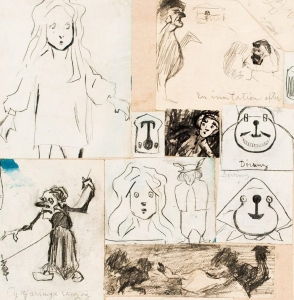
Pastor's son Nikolai Johannes Astrup was the eldest of fourteen children. His father Christian Astrup, was a parish priest at the Lutheran Ålhus Church in Jølster; his mother, Petra Konstanse, was the daughter of Peder Mørch Lodtz, a glove manufacturer from Bergen. Astrup was born in Bremanger in Sogn og Fjordane, Norway, but spent his formative years in nearby Ålhus. It is well known that Astrup rebelled against his father's strict Christian morality.
Education and Early Training
Astrup's father had hoped his eldest son would join the priesthood and duly sent him to study theology and Latin at the Trondheim Cathedral School between 1895 and 97. However, Astrup was drawn more to drawing and painting, and he performed poorly in his examinations. Following this setback, he returned home where he tutored his younger siblings, and designed wall hangings to be woven by his mother. Soon after, in 1899, he decided to move to Kristiania (now Oslo), where he spent just two weeks attending evening classes in printmaking at the Royal School of Drawing (Kongelige tegneskole), before going on to study at Harriet Backer's school of painting, where he remained until 1901. Here, he studied life drawing, worked in oil, produced his first etchings, and started to develop what was to become his neo-romantic style. Backer later described him as one of her most promising students: "I allowed him to work in the direction he wanted, as I understood he was the true genius of the school" she later recalled.
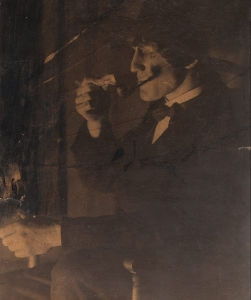
In 1901 Astrup moved to Paris to study under Norwegian artist Christian Krohg at the Académie Colarossi. Though he only attended for a year, Krohg, like Backer, spoke highly of Astrup, remarking that "When I speak of Mr. Nicolai Astrup as an artist, it cannot be the way an older artist speaks of a young artist as a 'beginner'. Mr. Astrup is in no way a beginner even though he has been painting for a very short time. His unique talent has brought him past the first phase of development, a period where most people stay for at least ten years." During his time in Paris, Astrup became enamored with Japanese ukiyo-e woodcuts, particularly those of Utagawa Hiroshige. He saw in these works an ideal style with which to present the vibrant, sometimes harsh, Norwegian landscape which he loved so dearly. He also developed an interest in photography at this time and invested in his first camera.
Whilst staying in Paris, Astrup made short trips to Berlin, Dresden and Hamburg with the aim of visiting museums and studying their treasures. He developed a particular interest in the French primitive painter, Henri Rousseau, and the Swiss Symbolist Arnold Böcklin. He once said of Böcklin, "It seems to me at the moment that there is no artist I understand as well as him, but maybe [he] is also easy for everyone to understand [...] what is most exciting about his pictures is their unexpectedness, a moment that sends a shiver down one's spine, and yet one can enjoy the sight of them for a long time afterwards." So taken with was he with Böcklin, in fact, that he named his first son (born in 1914) Arnold Böklin Astrup.
Mature Period
Astrup had his first solo exhibition at Blomqvist's Auction House and Gallery (Blomqvist's Kunsthandel) in Kristiania in 1905 (the same year that Norway gained independence from Sweden). As a direct result of this triumphant exhibition, Astrup sold several works and garnered widespread critical acclaim. He held other significant exhibitions at Bergen in 1908, and again in Kristiania in 1911. Astrup was by now recognized as Norway's most important artist, a status he enjoyed until his death.
Between 1906 and 1907, Astrup retreated to Sunde, which lies between the lakes of Jølstravatnet and Kjøsnesfjorden. One day, whilst working on a painting of the mountain Kleivefjellet (which he called Kollen), the weather took a turn for the worse, and he sought shelter at a nearby farm. Having become friends with the farmer and his family, the 26-year-old Astrup fell in love with the farmer's 15-year-old daughter, Engel Sunde. On December 23, 1907, the couple married, and they went on to parent eight children. Engel's young age caused some controversy, however, and for a time Astrup believed himself to be at risk of losing a grant. In a letter to his friend Henrik Lund, Astrup wrote, "It is true that I married a rather young girl but I do not think that it is immoral to a degree that I should be deprived of my stipend for that reason."
In early 1908, Astrup, having secured his stipend (from the Henrichsen fund) travelled to London where he visited the National Gallery, the Victoria and Albert Museum, and the Tate Gallery. He later said of the trip "I was in London. I wanted to go and see Constable, who painted [...] a similar nature to that of western Norway. I think he is the first landscape painter who understood landscape in colors." Later, In 1911, Astrup received a Houen travelling scholarship and this time visited Berlin, where he briefly studied at a private art school. His studies took him to numerous galleries and exhibitions, including the XXII Berlin Secession, where he was impressed by the paintings of Henri Matisse and the proto-expressionists, Max Slevogt, and Lovis Corinth.
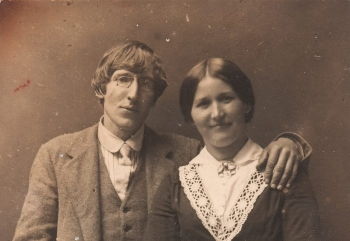
The married couple lived at a vicarage until their first child (daughter Kari) was born in 1911, after which they moved to Myklebust, on the south side of Jølstravatnet. In 1913, and following problems with the landlord, the pair relocated to old cotter's farm in Sandalstrand (now Astruptunet), on the south side of Lake Jølstravatn. Despite Astrup's growing reputation, the young family struggled financially, and the artist suffered health problems, including severe asthma. Nevertheless, Astrup continued to create art while also running and developing the farm. In fact, the farm and garden at Sandalstrand would become motifs in Astrup's later work.
Late Period
Even in later years, Astrup was open to new influences. In autumn 1916, for instance, he travelled with Bergen artists Moritz Kaland and Nils Krantz to Stockholm and Copenhagen in order to study modern French, Danish, and Swedish art.
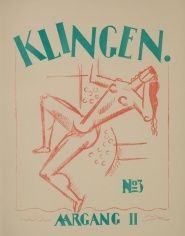
In 1917, he began subscribing to the newly published Danish language avant-garde periodical Klingen. Edited by ceramicist Axel Salto, writer Poul Uttenreitter, and, from 1918, author and critic Otto Gelsted, Klingen was published over 28 issues between 1917-20. Klingen whose contributors included Poul Uttenreiter, Tom Kristensen, Emil Bønnelycke, Gabriele Münter, Harald Giersing, Albert Naur, Per Krohg, Vilhelm Lundstrøm, allowed Astrup to keep abreast of international developments in Modern art and it informed his first exhibition of woodcuts in May 1918 at the Artists' Association, Kristiania.
In 1919, Astrup received a travel grant from the Conrad Mohr Foundation, but due to poor health he had to postpone further overseas travels. Astrup was greatly frustrated by this, and spent some time seriously considering either emigrating the United States or travelling to Munich to study with Wassily Kandinsky. As he said at the time, "I would like to study the abstract painters a little more closely - Kandinsky and the other Russians - basically they interest me more than the French - Picasso and Matisse - although I would really like to have a French painter such as Le Fauconnier as a teacher." In 1922, for health reasons once more, Astrup and Engel travelled to North Africa via Germany, Austria and Italy. They then spent some time in Tunis and Algiers, where their sixth child, Peder Alger Conrad, was born.
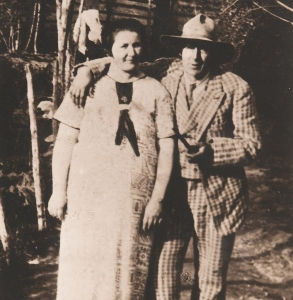
Astrup died of tuberculosis and pneumonia on January 21, 1928, at just 47 years of age. His wife, Engel, survived him by thirty-eight years and, in addition to raising their eight children (the last of which was born in 1926), she became a successful textile designer, and maintained the garden and buildings that she and Nikolai had built at Sandalstrand (since 1986, home to the Astruptunet gallery).
The Legacy of Nikolai Astrup
Commenting on an imminent career retrospective of his work at London's Dulwich Picture Gallery in 2016, the arts columnist, Maev Kennedy, noted that Astrup was little known outside of Norway where his "paintings are really loved". The Norwegian people's devotion to his art was the reason for his relative obscurity since there was "only one print and no painting in any British collection and [only] a handful in the US." Though the Dulwich exhibition would help bring the artist's vibrant and colorful talents to the wider attention of the public and the art establishment, hitherto, loans of his work had been hard to come by, outside the major collection held at Bergen. In Norway, however, Astrup enjoys near heroic status. So loved is he in fact that his images hang in schools, public buildings, and on so many of the walls of ordinary Norwegian homes. In the view of co-curator Ian Dejardin Astrup's painting was unique in the way it "rejected the stylistic trickery of aerial perspective, resulting in canvasses of intense immediacy and brightness of color"; while in prints, "he followed his own innovative path, laboriously reworking his woodcuts so that every print is a unique work of art." Dejardin was left to declare that Astrup now needed be "celebrated outside his native Norway."
One would be hard pressed to find reviews of Astrup's art that avoid comparisons with Munch. Indeed, the pair were both expressionists who transformed the literal world into one of sensational color. However, Astrup's work, especially after his marriage, tends to be brighter, less introspective, and more harmonious than his more famous compatriot. Arts columnist Claudia Massie asserts that Astrup possessed a singular childlike vision that gave his work "a remarkable natural clarity of light throughout" and which was "drenched in the wet hues of western Norway." His work, she concluded, is "simultaneously odd and truthful."
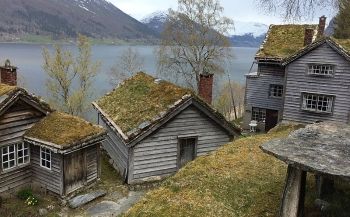
In 1986 the Astruptunet gallery, which features a permanent exhibition of Astrup's art, graphics, paintings, lithographs and sketches, was established within the idyllic rural surroundings of south Jølstravatnet. Astruptunet was not just the artist´s home, it became an important part of his creative life. According to Kennedy, "as a final work of art in its own right [Astrup had] built himself a home, Sandalstrand, on the precipitous shore of the lake that must be one of the most beautiful artists' homes in the world."
Influences and Connections

-
![Utagawa Hiroshige]() Utagawa Hiroshige
Utagawa Hiroshige -
![Henri Rousseau]() Henri Rousseau
Henri Rousseau -
![Arnold Bocklin]() Arnold Bocklin
Arnold Bocklin - J.C. Dahl
- Moritz Kaland
- Nils Krantz
-
![Impressionism]() Impressionism
Impressionism -
![Primitivism in Art]() Primitivism in Art
Primitivism in Art - Japanese woodcuts
- Neo-Romanticism
- Landscape painting
-
![Edvard Munch]() Edvard Munch
Edvard Munch -
![Remedios Varo]() Remedios Varo
Remedios Varo - Harald Sohlberg
- Moritz Kaland
- Nils Krantz
- Neo-Romanticism
- Landscape painting
